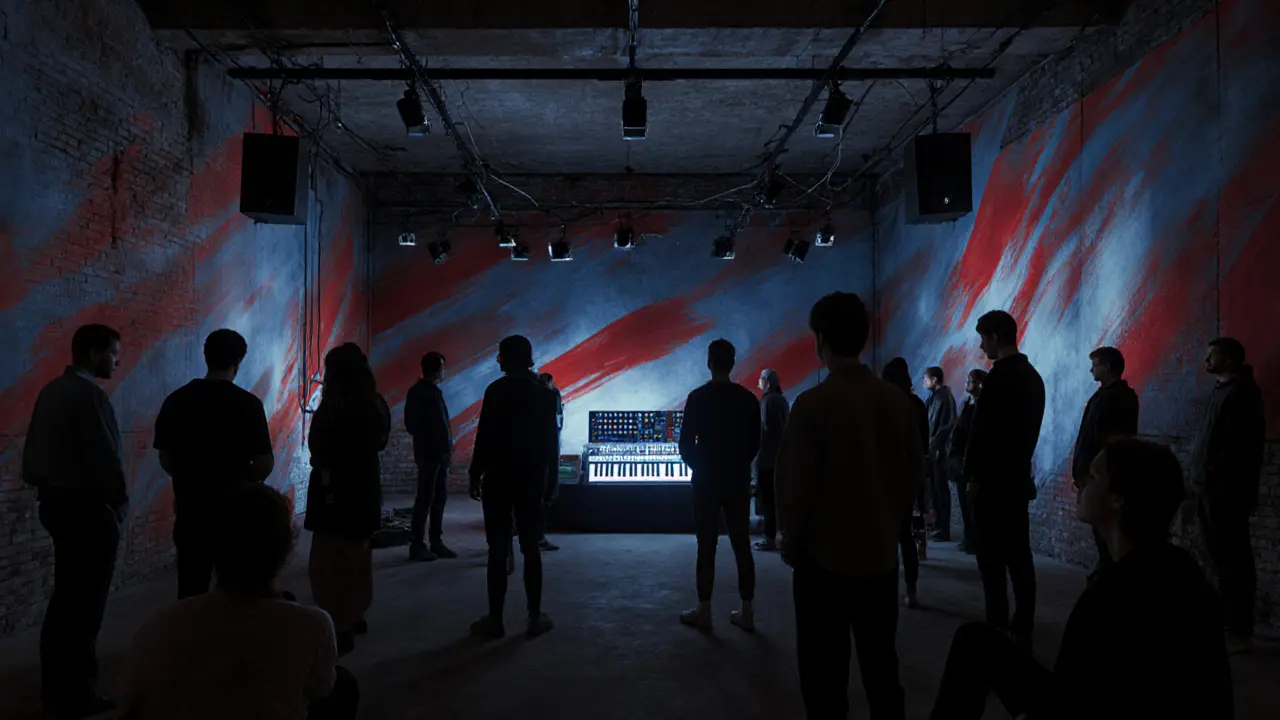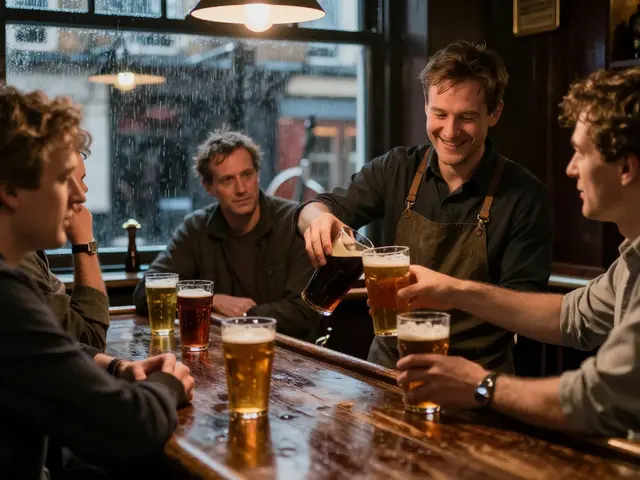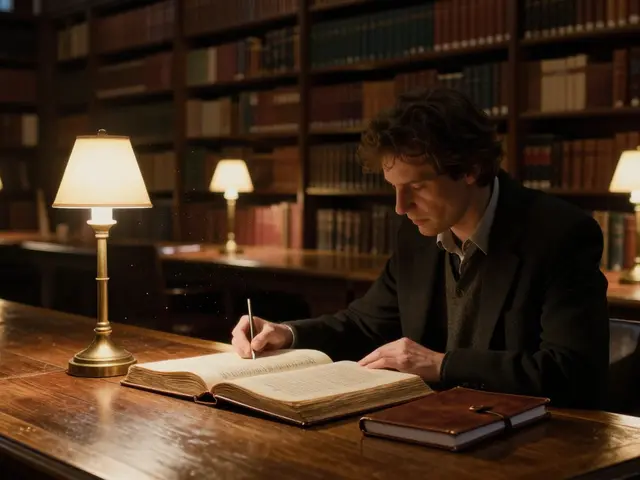
You’ve walked past it a hundred times - that unassuming brick building tucked between a laundromat and a dimly lit pub in North London. No neon sign. No bouncer. Just a small, weathered plaque that says Corsica Studios. But step inside, and you’re not in a club. You’re not in a gallery. You’re somewhere between them - where basslines shake the walls like heartbeat pulses, and projections crawl across concrete like living paint.
What Is Corsica Studios?
Corsica Studios isn’t just a venue. It’s a sonic laboratory. A warehouse-turned-art-space in Elephant and Castle that has quietly become one of London’s most vital places for experimental sound, immersive visuals, and boundary-pushing performances. Opened in 2014, it was born from the frustration of artists who couldn’t find a space that let them take risks - where noise could be art, where silence could be loud, and where the crowd didn’t just watch - they felt.
Unlike traditional clubs that chase trends, Corsica Studios thrives on the unpredictable. You might spend an evening listening to a 40-minute drone composition built from field recordings of subway tunnels, followed by a live set where a performer manipulates analog synths while surrounded by real-time generative video art. Or you could stumble into a midnight screening of an obscure 1970s experimental film, synced to a live ambient score played on modular gear.
This isn’t background music. This is sound you wear like a second skin.
Why Corsica Studios Matters
Most venues in London are designed to sell drinks and keep people moving. Corsica Studios is designed to make you stop. To listen. To feel something you didn’t know you were missing.
It’s a rare space where the art isn’t just on stage - it’s in the air, the lighting, the way the floor vibrates under your feet. Artists don’t perform here to get clicks or viral clips. They come because the acoustics are engineered for depth, the lighting system responds to sound frequencies, and the audience is there to be transformed, not just entertained.
Think of it like a cathedral for sonic exploration. No pews, no hymns - just pure, unfiltered audio experience. People travel from Berlin, Tokyo, and New York just to play here. And if you’ve ever wondered what true underground culture looks like in 2025, this is it.
What Happens at Corsica Studios?
There’s no typical night at Corsica Studios. That’s the point.
- Live Electronic Sets - From glitchy techno to abstract noise, DJs and producers bring gear that most clubs wouldn’t dare plug in. Expect modular synths, tape loops, and custom software that only exists in one person’s mind.
- Audiovisual Installations - Artists combine sound and moving imagery to create environments you step into, not just watch. One recent show used thermal cameras to project the heat signatures of the audience onto the walls, syncing with the music’s rhythm.
- Immersive Performances - Think dancers moving in total darkness while sound moves around you via 360-degree speaker arrays. Or a poet reciting in a room filled with suspended, vibrating strings that respond to voice.
- Workshops and Residencies - The space hosts monthly sessions where you can learn to build your own modular synth, or how to use field recordings to create ambient soundscapes. No experience needed - just curiosity.
You won’t find DJs spinning Top 40 remixes here. You won’t find bottle service. You won’t find people taking selfies at the bar. What you will find is a room full of people who’ve paid attention - and been changed by it.

How to Find Corsica Studios
Corsica Studios is at 260-262 Elephant Road, London SE17 1LN - right across from the Elephant & Castle tube station. It’s not flashy. Walk past the kebab shop, turn left at the graffiti-covered underpass, and you’ll see the double steel doors with no logo, just a small red light blinking above.
The best way to know what’s happening? Check their website or follow their Instagram. They don’t post events far in advance. Shows are often announced 24-48 hours before, sometimes even hours before doors open. That’s part of the magic - you have to be present, not just scheduled.
There’s no ticketing platform like Eventbrite. Tickets are sold at the door or through their simple, no-frills website. Cash only at the bar. No card machines. It’s a deliberate choice - to keep the space free from corporate control.
What to Expect When You Go
First, leave your expectations at the door. If you’re expecting a dance floor with strobe lights and a DJ in a hoodie, you’ll be confused. If you’re ready to be surprised, you’ll be amazed.
When you walk in, you’re greeted by a low hum - not music yet, but the building itself, breathing. The space is raw: exposed brick, high ceilings, concrete floors. No VIP section. No reserved tables. Just open space, a few low benches, and a stage that looks more like a science lab than a performance area.
Sound is everywhere. Speakers hang from the ceiling, line the walls, even sit on the floor. You don’t just hear the music - you feel it in your chest, your bones, your teeth. The lighting shifts slowly - deep blues, reds, flickering whites - reacting to the sound in real time.
People don’t crowd the front. They drift. Some sit cross-legged on the floor. Others stand still, eyes closed. A few sketch in notebooks. No one talks loudly. The energy isn’t hype - it’s reverence.
Pricing and Booking
Tickets are usually £10-£18, depending on the event. Some nights are pay-what-you-can, especially for student-run or community projects. Drinks are £4-£6 for beer, £5 for wine, £7 for cocktails - all made with care, not volume.
Doors open at 8 PM. Events start between 9 and 10 PM. Most shows end by 1 AM. There’s no last call. No rush. If the sound is still moving people, they’ll keep going.
Reservations aren’t possible. You show up. You pay. You stay as long as you’re moved. That’s it.

Why It’s Different From Other London Venues
Compare Corsica Studios to a typical London nightclub:
| Feature | Corsica Studios | Typical London Nightclub |
|---|---|---|
| Music Style | Experimental, avant-garde, immersive | Commercial EDM, pop remixes, top 40 |
| Atmosphere | Quiet, contemplative, immersive | Loud, crowded, social |
| Lighting | Dynamic, sound-reactive, artistic | Strobe, lasers, predictable patterns |
| Sound System | High-fidelity, multi-speaker, spatial audio | Basic club system, optimized for bass |
| Attendance | 150-300 people, curated crowd | 500-1000+, general public |
| Booking | Walk-in or simple online | Pre-booked via apps, often with guest lists |
| Goal | Experience, transformation | Drinks, socializing, dancing |
Corsica Studios doesn’t compete with clubs. It exists outside the system. It’s not trying to be the biggest. It’s trying to be the most honest.
Frequently Asked Questions
Is Corsica Studios open every night?
No. Corsica Studios hosts events only a few nights a week - usually Wednesday through Saturday. They don’t run daily. Check their website or Instagram for the weekly schedule. Some weeks have no events at all, especially during holidays or artist residencies.
Can I bring my own drinks?
No. Outside alcohol isn’t allowed. But the bar offers affordable, well-made drinks, and they’re happy to make non-alcoholic options if you ask. The space is designed to be a controlled environment - both for sound quality and safety.
Is it accessible for people with disabilities?
Yes. The venue has step-free access, accessible toilets, and hearing loops for sound systems. They also offer quiet hours on select nights for neurodivergent visitors. If you have specific needs, email them ahead of time - they’re responsive and accommodating.
Do people dance at Corsica Studios?
Sometimes. But not like in a club. People move - sway, shift, lean into the sound. Dancing isn’t the goal. Connection is. You might see someone slowly turning in circles, eyes closed, lost in the rhythm. That’s the dance here.
Are there any age restrictions?
Yes. Most events are 18+. Some late-night experimental shows may be 21+, especially if alcohol is involved. Always check the event listing. ID is required.
Final Thought: Go With No Expectations
Corsica Studios doesn’t advertise. It doesn’t need to. It survives because people who’ve been there tell others - quietly, seriously, like sharing a secret that changed them.
If you’re tired of the same beats, the same lights, the same crowd - go. Don’t research the lineup. Don’t ask what kind of music they play. Just show up. Let the space take you. Let the sound wash over you. You might not understand it. You might not like it. But you’ll never forget it.







5 Comments
I went last week and it was the most overhyped place ever 😒 Like, the sound was just... loud. And the 'art' was just flickering lights on a wall. I’ve seen better visuals at a Walmart holiday sale. Why is everyone acting like this is the second coming of music? 🙄/p>
I really appreciate how Corsica Studios creates space for artists who don’t fit the mainstream mold. There’s something sacred about a place that doesn’t chase trends - where you can just sit and let sound move through you without pressure to dance or post or perform. I went on a Wednesday night and didn’t leave until 12:45, even though I had an early morning. It felt like a gift. 🌿/p>
It is imperative to acknowledge the deliberate, almost radical ethos of Corsica Studios - a space uncorrupted by corporate sponsorship, ticketing platforms, or algorithmic promotion. The absence of card machines, the cash-only policy, the lack of scheduled announcements - these are not quirks. They are acts of resistance. In an era where every experience is monetized and mediated, this venue stands as a quiet monument to authenticity. One must approach it with reverence, not expectation. I am profoundly moved by its existence./p>
I’ve been to a few experimental venues in Berlin and NYC, and Corsica really holds its own. The spatial audio setup is next level - I could feel the low frequencies in my jaw. And the thermal camera art piece? Genius. It’s rare to find a place where the audience is so quietly engaged. No phones out, no shouting over the music - just people listening. It’s the kind of space that reminds you why you fell in love with sound in the first place. 🎧/p>
Let me break this down for you: Corsica Studios isn’t an art space - it’s a psyop. They’re using subsonic frequencies to manipulate crowd behavior. I did a deep dive into the building’s blueprints and the speaker array is identical to the ones used in CIA mind-control experiments from the 1970s. The ‘thermal art’? That’s surveillance tech repurposed as ‘immersive experience.’ The ‘no ticketing’ thing? That’s to avoid tracking who comes and goes. They’re harvesting biometric data from your body’s reaction to sound - heart rate, skin conductivity - and selling it to neurotech firms. And don’t get me started on the ‘pay what you can’ nights - that’s how they target vulnerable people for psychological profiling. This isn’t underground culture. It’s a front for a black-budget project. I’ve seen the receipts. If you go, wear a Faraday cage hat. And bring a signal jammer. 🛡️📡🧠/p>